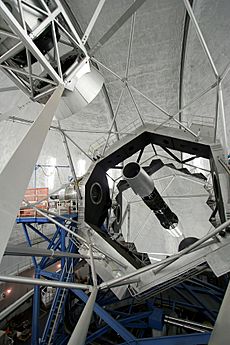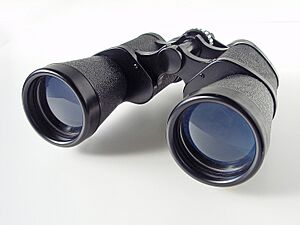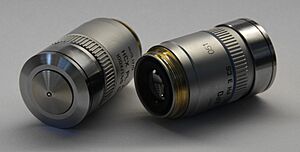Objective (optics) facts for kids
An objective is a special part of an optical tool that collects light from something you are looking at. It then focuses these light rays to create a clear image of that object. Think of it as the "eye" of the instrument.
Objectives can be a single lens or mirror, or a group of them working together. You can find objectives in many tools like microscopes, binoculars, telescopes, cameras, and even CD players. They are also sometimes called object lenses or objective glasses.
Contents
Microscope Objectives
In a microscope, the objective lens is the part closest to the sample you are examining. It works like a very powerful magnifying glass with a very short focal length. This means it needs to be very close to the specimen. Its main job is to gather light from the tiny sample.
Magnification Power
One of the most important features of microscope objectives is how much they magnify. This power usually ranges from 4 times (4×) to 100 times (100×).
The objective's magnification works with the eyepiece's magnification to give you the total view. For example, a 4× objective with a 10× eyepiece makes the object appear 40 times larger than it really is.
Most microscopes have three or four objective lenses. These are screwed into a spinning part called a "nosepiece." You can rotate this nosepiece to choose the lens you want to use. These lenses are often color-coded to make them easier to pick.
- The least powerful lens is usually called the scanning objective lens, often 4×.
- The next one is the small objective lens, typically 10×.
- The most powerful is the large objective lens, which can be 40× or even 100×.
Numerical Aperture
The numerical aperture (NA) of a microscope lens tells you how much light it can gather and how much detail it can show. A higher NA means the lens can collect more light and give you a clearer, more detailed image. For microscope lenses, NA usually ranges from 0.10 to 1.25.
Cover Slip Thickness
When you look at samples under a microscope, especially in biology, they are often placed under a thin piece of glass called a cover slip. This cover slip can slightly change the image.
Some objectives are made to correct for these changes. They often have the ideal cover slip thickness (like 0.17 mm) written on their side. Other objectives, used for looking at metal surfaces, don't need cover slips. This difference is more important for high-magnification lenses.
Lens Design for Clear Images
Simple glass lenses can cause problems with colors, making the image blurry or showing colored fringes. This is called chromatic aberration. To fix this, most objectives have special designs.
- An achromatic lens uses different types of glass to focus two colors at the same point. These are common.
- More advanced designs, like apochromat objectives, correct colors even better.
Another issue is spherical aberration, where the center of the image is clear but the edges are blurry. When an objective is designed to fix this, it's called a "plan" objective. It gives you a flat, clear image across the whole view.
Working Distance
The working distance is the space between the objective lens and the sample. As you use higher magnification, this distance usually gets smaller. This means the lens gets very close to your sample. If you need more space, there are special "long working distance" objectives.
Immersion Lenses
Some microscopes use special oil-immersion or water-immersion lenses. These can magnify more than 100 times and offer even better detail. For these lenses to work, a drop of special oil or water must fill the tiny gap between the lens and the sample. This helps gather more light and gives a super clear image.
Mounting Threads
Microscope objectives screw into the microscope body. There's a common standard for these screws, set by the Royal Microscopical Society in 1858. It's called the "RMS thread" and is still widely used today. Other manufacturers might use slightly different metric screw sizes.
Photography and Imaging

In cameras, objectives are usually called "photographic objectives" or simply "lenses." They are made of many different glass parts. This helps them create a clear image over a large area, correcting any problems with the light.
Projectors, like those for videos or slides, use objective lenses that do the opposite of camera lenses. They take a large image and project it onto a screen far away.
Telescopes

In a telescope, the objective is the main lens at the front of a refracting telescope (like binoculars) or the main primary mirror in a reflecting telescope.
The size of a telescope's objective lens or mirror (its "aperture") is very important. A larger objective can gather more light, making objects appear brighter. It also helps the telescope see more fine details.
See also
 In Spanish: Objetivo (óptica) para niños
In Spanish: Objetivo (óptica) para niños
- List of telescope parts and construction
- Etendue




